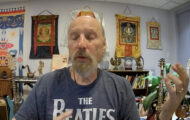Something is Missing
Happy Friday!
I’ve been very busy working on my public health program. I’m taking some vacation time so I have the head-space to work on this project and don’t have to try and fit it between appointments.
You’d think that putting a program together for the public would be an easy “Dr. Seuss” task, but, as some of us well know, it takes a wise man to express the complex in simple terms.
That said, I’m having to do a lot of tai-chi and different types of meditations to get centered and synthesize a large number of essential factors.
Fortunately, when I was in the military, one of my jobs was to take all the soldiers that failed their fitness testing and get them into top shape. I was very successful at it and will now apply some of those leadership skills and training techniques to the public.
Don’t worry, I’m not creating another boot-camp where people get yelled at, hear off-colored comments about their mothers, or get dirt kicked in their face…
Recently, one of our CHEK Faculty Instructors was teaching in England and I received an email from him yesterday with a photo attached.

In the photo above, you can see CHEK Faculty Dan Hellman and our CHEK Europe Partner, Gavin Jennings standing near a rock stack I created about two years ago while lecturing at Loughborough University in Loughborough, UK.
Last year, I was really surprised it was still standing when I came back to lecture, but to see it still standing another year later is quite cool!
I like to leave a little natural beauty where ever I go. The fact that the Landlord of the property has left it up all this time suggests that he enjoys it too.
Today I’ll be working away on my big project, and will continue to do so in the peaceful expanse of my Heaven House property here at work.
Yesterday, for my workout, I dismantled what my client Jason and I had built a few weeks ago and created a labyrinth.
I love to feel the energies created by different patterns and symbols as I do rock work. Today, I’ll probably build something tall, like an Indian Totem pole out of stone.
Please enjoy today’s Tao-Te-zen: Something’s Missing
Something’s missing in the tree; hollow are the branches.
Something’s missing in the sky; hollow is that whole.
Something rises in the well – yet, hollow is that hole.
Something pulls the ocean tides – yet only the moon can know.
Something’s missing in the sun – yet you see it glow.
Who is the guest knocking at the door?
Which book will you greet?
Zen gardener’s on hands and knees
Something’s missing
Is it the weeds?
Or rocks in beautiful rows.
Zen practice honors empty space.
You cannot fill the full.
Something’s missing from the sheep
Is it your clothes of wool?
Let spirit fill your heart
Your lungs and your mind
Zen practice honors the empty as the full
Wholeness living as functional utility!
That is zen.
“Something’s Missing” is a sutra that points to the nature of reality, as we know it. This sutra explains the true nature of “mind” as well as that of functionality and utility.
Mind is the generator of thoughts. All thoughts are incomplete. The very motive force for thought is the desire to acquire that which is perceptibly missing from an individual’s ideosphere, or sphere of conscious appreciation, of any idea.
The mind doesn’t think about anything that is complete, it thinks about the fragments.
Our thoughts are so commonplace that it is easy, natural to our understanding of self, to think that they are complete – we think our thoughts are inherent to one’s “being.”
When the mind’s understanding is incomplete as to how or why to do something, we naturally think about it in attempt to gain a more complete perspective – a greater awareness.
For example, the body has fundamental intelligence as to how to breathe, circulate blood, digest and eliminate to the degree that such actions occur naturally without any conscious thought.
When any of these functions are compromised in any way, we can rest assured that something’s missing!
By necessity then, we will think about those bodily actions in attempt to regain the information or knowledge necessary to restore wholeness to our being.
Wholeness emerges when thinking stops and function returns.
The very nature of mind is its incompleteness. All ideas can only exist in a kind of codependence with all other ideas.
For example, one can know a tremendous amount about trees, yet without knowledge of the soil, of the earth, of the sky, of water, of insects and diseases that may affect the tree, one’s knowledge is still incomplete and therefore, they will be subject to reality-something’s missing!
Even when one knows these things, one’s knowledge of trees is still incomplete without knowledge of seasons and the movements of planets and stars, for their influence over trees is as integral to the life of a tree as any other aspect of influence on the trees at large.
Just because we perceive something doesn’t guarantee that we truly know it. More often, the ego does its best to fill in the blanks using thought.
Something’s missing is also the essential nature of utility and functionality.
It is the fact that something’s missing from the cup that offers utility to the cup. If there were no empty space in the cup, you could not use it as a cup, it may make a paperweight, but not a cup.
If there wasn’t something missing from the handle, it might be too hot to hold, which would diminish its utility.
Something’s missing is a sutra that implies that what is missing in life is essential for the flow of transformation that creates life itself. Life is a perpetual transition of appearances and disappearances.
When we learn to use our minds effectively, we are capable of cultivating functionality and utility in a way that enhances our direct experience of life.
When we chase perpetually after the missing, yet acquire so much information, we inadvertently cultivate incompatibility by the mere nature of the incompatibility of ideas.
We decrease functionality and utility in our lives, though we may appear knowledgeable to those whose idea of intelligence is based on intellectual knowledge.
We lack the logic, rationality and practicality to differentiate something useful from something incompatible or we lack the creativity to see otherwise.
To apply your practice lesson effectively in your life, simply become aware of the benefits of “Something Missing.”
Is what’s missing necessary to produce functionality or utility?
Is the nature of something missing recognized for its very absence to facilitate life?
Meditate on whether your search for the apparent “something missing” is actually practical, or are you simply in a habit of over intellectualizing “the something.”
On a personal level, zen is a practice of recognizing that when we feel something’s missing within ourselves, we seek to be responsible and acquire it through our own efforts.
If we repeatedly expect others to fill our perceived emptiness, we become parasitic in relationships and risk losing our individuality. To the degree that we lose our individuality, we at once detract from the collective whole.
Zen is the practice of honoring the missing and cultivating functionality, utility and wholeness.
In zen, “Something’s Missing” is a reminder that our very life is a process of both fulfillment and emptying.
What’s missing is very often what we have.
That is zen.
I hope you enjoyed the Tao-Te-zen lesson today and that you have a lovely weekend!
Love and chi,
Paul Chek
















Find me on the web